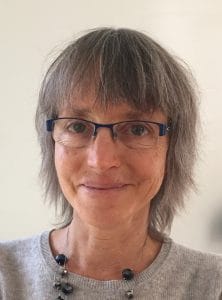Nancy Kanwisher
MIT
 Nancy Kanwisher received her B.S. and Ph.D. from MIT working with Molly Potter. After a postdoc as a MacArthur Fellow in Peace and International Security, and a second postdoc in the lab of Anne Treisman at UC Berkeley, she held faculty positions at UCLA and then Harvard, before returning to MIT in 1997, where she is now an Investigator at the McGovern Institute for Brain Research, a faculty member in the Department of Brain & Cognitive Sciences, and a member of the Center for Minds, Brains, and Machines. Kanwisher’s work uses brain imaging to discover the functional organization of the human brain as a window into the architecture of the mind. Kanwisher has received the Troland Award, the Golden Brain Award, and a MacVicar Faculty Fellow teaching Award from MIT, and she is a member of the National Academy of Sciences and the American Academy of Arts and Sciences. You can view her short lectures about human cognitive neuroscience for lay audiences here: http://nancysbraintalks.mit.edu
Nancy Kanwisher received her B.S. and Ph.D. from MIT working with Molly Potter. After a postdoc as a MacArthur Fellow in Peace and International Security, and a second postdoc in the lab of Anne Treisman at UC Berkeley, she held faculty positions at UCLA and then Harvard, before returning to MIT in 1997, where she is now an Investigator at the McGovern Institute for Brain Research, a faculty member in the Department of Brain & Cognitive Sciences, and a member of the Center for Minds, Brains, and Machines. Kanwisher’s work uses brain imaging to discover the functional organization of the human brain as a window into the architecture of the mind. Kanwisher has received the Troland Award, the Golden Brain Award, and a MacVicar Faculty Fellow teaching Award from MIT, and she is a member of the National Academy of Sciences and the American Academy of Arts and Sciences. You can view her short lectures about human cognitive neuroscience for lay audiences here: http://nancysbraintalks.mit.edu
Functional Imaging of the Human Brain as a Window into the Mind
Saturday, May 20, 11:00 am – 12:00 pm, Museum of Fine Arts, St. Petersburg, Florida
Twenty-five years ago with the invention fMRI it became possible to image neural activity in the normal human brain. This remarkable tool has given us a striking new picture of the human brain, in which many regions have been shown to carry out highly specific mental functions, like the perception of faces, speech sounds, and music, and even very abstract mental functions like understanding a sentence or thinking about another person’s thoughts. These discoveries show that human minds and brains are not single general-purpose devices, but are instead made up of numerous distinct processors, each carrying out different functions. I’ll discuss some of the evidence for highly specialized brain regions, and what we know about each. I’ll also consider the tantalizing unanswered questions we are trying to tackle now: What other specialized brain regions do we have? What are the connections between these each of these specialized regions and the rest of the brain? How do these regions develop over infancy and childhood? How do these regions work together to produce uniquely human intelligence?
Attending the Public Lecture
The lecture is free to the public with admission to the museum. Museum members are free; Adults $17; Seniors 65 and older $15; Military with Id $15; College Students $10; Students 7-18 $10; Children 6 and under are free. VSS attendees will receive free admission to the Museum by showing your meeting badge.
About the VSS Public Lecture
The annual public lecture represents the mission and commitment of the Vision Sciences Society to promote progress in understanding vision, and its relation to cognition, action and the brain. Education is basic to our science, and as scientists we are obliged to communicate the results of our work, not only to our professional colleagues but to the broader public. This lecture is part of our effort to give back to the community that supports us.
